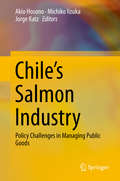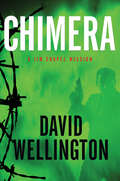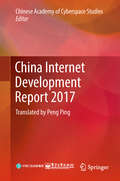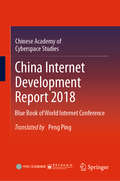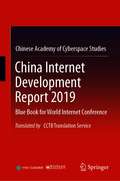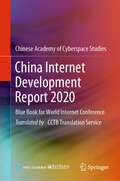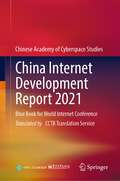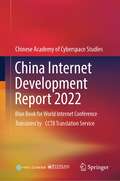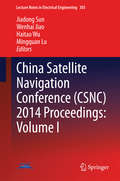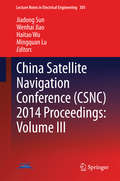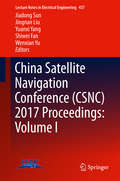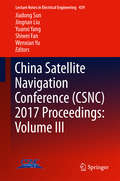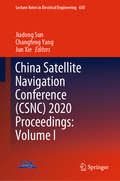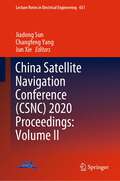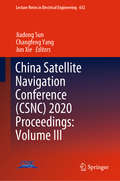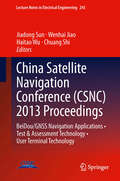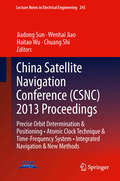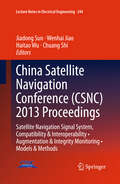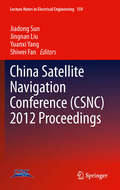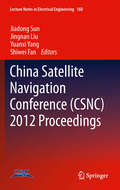- Table View
- List View
Chile's Salmon Industry: Policy Challenges in Managing Public Goods
by Akio Hosono Michiko Iizuka Jorge KatzThis book is the first to analyze Chile's salmon farming industry in discussing industrial development in terms of the management of public goods. The book highlights important aspects of learning and capacity development, environmental sustainability, institutions, and social welfare or inclusiveness. With aquaculture now providing almost half the global fish harvest, Chile's salmon farming and processing industry stands out as a leader in the new "blue revolution". Taking a holistic, historic approach to understanding the evolutionary development of the industry, the authors employ this strategy in the belief that policy discussions of economic activities have become highly segmented and often provide only a partial picture. Such segmentation is problematic for policy studies based on a complex web of interactions among numerous agents. The present volume untangles this web by considering the development of the Chilean salmon industry not only in holistic and historic terms but also from a socioeconomic point of view. The valuable book offers insightful lessons that can be applied to other natural resource-based sectors facing similar challenges in the course of development. Normal 0 false false false EN-US JA X-NONE /* Style Definitions */ table. MsoNormalTable {{mso-style-name:標準の表; mso-tstyle-rowband-size:0; mso-tstyle-colband-size:0; mso-style-noshow:yes; mso-style-priority:99; mso-style-parent:""; mso-padding-alt:0cm 5. 4pt 0cm 5. 4pt; mso-para-margin-top:0cm; mso-para-margin-right:0cm; mso-para-margin-bottom:10. 0pt; mso-para-margin-left:0cm; line-height:115%; mso-pagination:widow-orphan; font-size:11. 0pt; font-family:"Calibri","sans-serif"; mso-ascii-font-family:Calibri; mso-ascii-theme-font:minor-latin; mso-hansi-font-family:Calibri; mso-hansi-theme-font:minor-latin;}}
Chimera
by David WellingtonA band of genetically modified killers has smashed out of a secret military facility in upstate New York, and Special Forces veteran Jim Chapel gets to puzzle out whether theyre renegades or part of a high-up conspiracy. Author of the "Monster Island" trilogy, serialized online zombie novels, Wellington is currently working toward a degree in Library Science at the Pratt Institute.
Chimera
by David WellingtonAfghanistan veteran Jim Chapel has been enlisted in a new war.This time it's in his own backyard . . . and even more deadly.A small band of fugitives escapes from a secret upstate New York military facility, leaving a trail of bodies in its wake. Each fugitive has a target--an innocent civilian--and will not stop until that target has been eliminated.Wounded Special Forces veteran Jim Chapel has been stuck behind a desk rather than out in the field, but medical technology has finally caught up with his ambitions. Coupled with his unstoppable determination, it will take him back to where he thrives: the thick of the action.Drafted into a new war, this time in our homeland, Chapel is tasked with hunting a group of escapees from a top secret military compound--all extremely deadly, genetically modified killers--and unraveling the mystery behind their existence. Aided by an enigmatic woman named Angel and a courageous, beautiful veterinarian, Chapel begins a cross-country hunt to stop the murders. But are the killers really rogues, or are they part of a sinister conspiracy that reaches into the highest levels?
China Automotive Low Carbon Action Plan (2022): Low Carbon Development Strategy and Transformation Path for Carbon Neutral Automotive
by Automotive Data of China Co., LtdThis book studies the low-carbon transformation path of the automotive industry. It makes a quantitative analysis of the emission reduction potential of the transformation path based on the systemic accounting of the carbon emissions in the whole life cycle of automobiles. The content puts forward scientific and reasonable suggestions on Chinese automobiles' low-carbon development strategy and transformation path.This book is used as a reference for professionals in the automotive industry who are engaged in automotive life cycle assessment, carbon footprint research, carbon neutrality planning research, etc. It is also used as a reference book for students in automotive in universities.
China Food and Drug Law: Policy, Practice, and Future Directions (Law for Professionals)
by John C. BalzanoThis book is an analysis of policy and law governing the development, approval, manufacture, distribution, marketing and post-market surveillance of human drugs, medical devices, foods and cosmetics in Mainland China (“China FDD Regulation”). It analyzes the policy and general principles behind China FDD Regulation, including the history and jurisdiction of the central and local agencies that administer the laws and regulations, the administrative law structure in which these agencies operate, and other aspects of FDD Regulation interpretation and enforcement. Although it describes practice in China, this book is written in the comparative perspective (i.e., sensitive to assumptions made by those who are steeped in FDD Regulation in the U.S., Japan, and the EU). It includes one chapter on each regulatory space (drugs, medical devices, cosmetics, and food) organized by the lifecycle of products. It also covers subcategories of products, such as vaccines, radiopharmaceuticals, and in vitro diagnostic medical devices. The book includes specialty chapters on areas that are common to multiple types of regulated products, such as biosecurity and advertising. It is the first English language book of its kind, and it can serve as a resource for those in the FDD law and regulatory field to understand the mechanics of developing and marketing products, but also with insights for businesspeople and others, who are developing China-strategies.
China Internet Development Report 2017: Translated by Peng Ping
by Chinese Academy of Cyberspace StudiesThis book provides a comprehensive review of China’s Internet development in the past 23 years since the country’s first access to the Internet, especially since the 18th National Congress of the Communist Party of China. It offers a systematic account of China’s experience in Internet development and governance, and establishes and presents China’s Internet Development Index System, covering network infrastructure, information technology, digital economy, e-governance, cyber security, and international cyberspace governance.
China Internet Development Report 2018: Blue Book of World Internet Conference
by Chinese Academy of Cyberspace StudiesThis book is an important outcome of the Fifth World Internet Conference. It provides a comprehensive review of China’s Internet development, especially the new practice and achievement in 2018. And it offers a systematic account of China’s experience in Internet development and governance. This year, the book improves China’s Internet Development Index System, optimizes the algorithm model, and enhances data collection, to assess and reflect Internet development more comprehensively, objectively and scientifically.
China Internet Development Report 2019: Blue Book for World Internet Conference, Translated by CCTB Translation Service
by Chinese Academy of Cyberspace StudiesThis book systematically summarizes China Internet development over the past 25 years, highlighting its strong impact on China’s economy and society, and discussing the Chinese people’s transition from beneficiaries and participants to builders, contributors and joint maintainers of cyberspace development. It describes the development achievements, status and development and trends in China Internet in 2019, systematically summarizes the main lessons learned during development, and analyzes China’s strategic planning and policy actions. Further, it discusses topics such as development outcomes, future trends in information infrastructure, network information technology, digital economy, e-government, construction and management of network contents, cyberspace security, the legal construction of cyberspace, and international cyberspace governance. In addition, the book suggests improvements to the index system for China Internet development and offers an overall assessment of cyberspace security and informatization work throughout China in order to comprehensively and accurately demonstrate the level of China Internet development.
China Internet Development Report 2020: Blue Book for World Internet Conference
by Chinese Academy of Cyberspace StudiesThis book systematically summarizes the development process of China Internet in 2020, reveals the strong impact of Internet on China's economic development and social progress, and displays the course of the Chinese people's changes from beneficiary and participant to builder, contributor, and joint maintainer of cyberspace development and security during the Internet development; objectively reflects the development achievements, development status, and development trend of China Internet in 2020, systematically summarizes the main experience in the development of China Internet, and deeply analyzes China's strategic planning, policy actions, development results, practical level and future trend in information infrastructure, network information technology, digital economy, E-government, construction and management of network contents, network security, legal construction of cyberspace, international cyberspace governance, and other aspects; further improves the index system for the development of China Internet and makes an overall assessment of network security and informatization work in 31 provinces (autonomous regions and municipalities directly under the central government, excluding Hong Kong, Macao, and Taiwan) throughout China from 6 aspects, in the hope of reflecting the Internet development level throughout China and individual places comprehensively and accurately. With the important thoughts of General Secretary Xi Jinping on the national cyber development strategy as the main line running through the book, this book collects the latest research results in the domestic Internet field and utilizes the latest cases and authoritative data; featuring rich contents and highlights, this book helps the public readers to better comprehend the rich implications, spiritual essence, and practice requirements of the Internet governance concepts, thoughts, and opinions of General Secretary Xi Jinping and provides an important reference value for the employees in the Internet fields, such as government departments, Internet enterprises, scientific research institutions, colleges, and universities to fully understand and master the development of the China Internet.
China Internet Development Report 2021: Blue Book for World Internet Conference
by Publishing House of Electronics IndustryThis book objectively represents the achievements, status quo, and trends of China Internet development in 2021, systematically summarizes the main experience of China Internet development, and deeply analyzes the strategic planning, policies and measures, and development achievements, level, and trends in China in terms of eight aspects, i.e., information infrastructure, information technology, digital economy, e-government, cyber content, cybersecurity, cyberlaws, international cyberspace governance, and exchanges and cooperation. This book further optimizes the index system of China Internet development and comprehensively evaluates the work of cybersecurity and informatization in 31 provinces (autonomous regions, municipalities directly under the Central Government, excluding Hong Kong, Macao, and Taiwan) across the country from six dimensions, in order to mirror Internet development level in China and various regions in a comprehensive, accurate, and objective way.This book collects the latest research results in China Internet development and selects the latest cases and reliable data. With diverse subjects and detailed discussion, this book possesses great significance for these engaged in Internet field in governmental departments, Internet enterprises, scientific research institutions, and universities, who hope to fully understand China Internet development.
China Internet Development Report 2022: Blue Book for World Internet Conference
by Publishing House of Electronics IndustryThis book objectively presents the achievements, status quo, and trends of China's Internet development in 2022, systematically summarizes the major experiences of China's Internet development, and deeply analyses the strategic planning, policies and measures, and development achievements, level and trends in China in terms of eight aspects, i.e. information infrastructure, digital economy, e-government, digital society, cyber content, cybersecurity, cyber law, international cyberspace governance, and exchange and cooperation. This book further optimizes the index system of China's Internet development and comprehensively evaluates the work of cybersecurity and informatisation in 31 provinces (autonomous regions, municipalities directly under the Central Government, excluding Hong Kong, Macao and Taiwan) across the country from six dimensions, so as to reflect the Internet development level in China and various regions in a comprehensive, accurate and objective way. This book collects the latest research results on China's Internet development and selects the most recent cases and reliable data. With diverse topics and in-depth discussions, this book is of great significance to those involved in the Internet field in government departments, Internet enterprises, scientific research institutions, and universities who hope to fully understand China's Internet development.
China Mobile Source Environmental Management (2016—2020)
by Yan Ding Hang Yin Junfang Wang Zhihui Huang Zhuoshi HeMobile source pollution has become an important source of air pollution in large and medium-sized cities in China, and it also causes particulate matter and photochemical smog pollution. This book introduces the mobile source law, regulation and standards policy system. It presents a panoramic view of China's achievements in mobile source environmental management. It also reviews latest energy-saving and emission reduction technologies to provide reference for all sectors of society to gain a deeper understanding of mobile source environmental management.
China Satellite Navigation Conference (Lecture Notes in Electrical Engineering #303)
by Jiadong Sun Wenhai Jiao Haitao Wu Mingquan LuChina Satellite Navigation Conference (CSNC) 2014 Proceedings presents selected research papers from CSNC2014, held on 21-23 May in Nanjing, China. The theme of CSNC2014 is 'BDS Application: Innovation, Integration and Sharing'. These papers discuss the technologies and applications of the Global Navigation Satellite System (GNSS) and the latest progress made in the China BeiDou System (BDS) especially. They are divided into 9 topics to match the corresponding sessions in CSNC2014, which broadly covered key topics in GNSS. Readers can learn about the BDS and keep abreast of the latest advances in GNSS techniques and applications. SUN Jiadong is the Chief Designer of the Compass/ BDS and the Academician of Chinese Academy of Sciences (CAS); JIAO Wenhai is a researcher at China Satellite Navigation Office; WU Haitao is a professor at Navigation Headquarters, CAS; LU Mingquan is a professor at Department of Electronic Engineering of Tsinghua University.
China Satellite Navigation Conference (Lecture Notes in Electrical Engineering #305)
by Jiadong Sun Wenhai Jiao Haitao Wu Mingquan LuChina Satellite Navigation Conference (CSNC) 2014 Proceedings presents selected research papers from CSNC2014, held on 21-23 May in Nanjing, China. The theme of CSNC2014 is 'BDS Application: Innovation, Integration and Sharing'. These papers discuss the technologies and applications of the Global Navigation Satellite System (GNSS) and the latest progress made in the China BeiDou System (BDS) especially. They are divided into 9 topics to match the corresponding sessions in CSNC2014, which broadly covered key topics in GNSS. Readers can learn about the BDS and keep abreast of the latest advances in GNSS techniques and applications. SUN Jiadong is the Chief Designer of the Compass/ BDS and the Academician of Chinese Academy of Sciences (CAS); JIAO Wenhai is a researcher at China Satellite Navigation Office; WU Haitao is a professor at Navigation Headquarters, CAS; LU Mingquan is a professor at Department of Electronic Engineering of Tsinghua University.
China Satellite Navigation Conference (Lecture Notes in Electrical Engineering #437)
by Jiadong Sun Jingnan Liu Shiwei Fan Yuanxi Yang Wenxian YuThese proceedings present selected research papers from CSNC2017, held during 23th-25th May in Shanghai, China. The theme of CSNC2017 is Positioning, Connecting All. These papers discuss the technologies and applications of the Global Navigation Satellite System (GNSS), and the latest progress made in the China BeiDou System (BDS) especially. They are divided into 12 topics to match the corresponding sessions in CSNC2017, which broadly covered key topics in GNSS. Readers can learn about the BDS and keep abreast of the latest advances in GNSS techniques and applications.
China Satellite Navigation Conference (Lecture Notes in Electrical Engineering #438)
by Jiadong Sun Jingnan Liu Shiwei Fan Yuanxi Yang Wenxian YuThese proceedings present selected research papers from CSNC2017, held during 23th-25th May in Shanghai, China. The theme of CSNC2017 is Positioning, Connecting All. These papers discuss the technologies and applications of the Global Navigation Satellite System (GNSS), and the latest progress made in the China BeiDou System (BDS) especially. They are divided into 12 topics to match the corresponding sessions in CSNC2017, which broadly covered key topics in GNSS. Readers can learn about the BDS and keep abreast of the latest advances in GNSS techniques and applications.
China Satellite Navigation Conference (Lecture Notes in Electrical Engineering #439)
by Jiadong Sun Jingnan Liu Shiwei Fan Yuanxi Yang Wenxian YuThese proceedings present selected research papers from CSNC2017, held during 23th-25th May in Shanghai, China. The theme of CSNC2017 is Positioning, Connecting All. These papers discuss the technologies and applications of the Global Navigation Satellite System (GNSS), and the latest progress made in the China BeiDou System (BDS) especially. They are divided into 12 topics to match the corresponding sessions in CSNC2017, which broadly covered key topics in GNSS. Readers can learn about the BDS and keep abreast of the latest advances in GNSS techniques and applications.
China Satellite Navigation Conference (Lecture Notes in Electrical Engineering #650)
by Jiadong Sun Changfeng Yang Jun XieChina Satellite Navigation Conference (CSNC 2020) Proceedings presents selected research papers from CSNC 2020 held during 22nd-25th November in Chengdu, China. These papers discuss the technologies and applications of the Global Navigation Satellite System (GNSS), and the latest progress made in the China BeiDou System (BDS) especially. They are divided into 13 topics to match the corresponding sessions in CSNC2020, which broadly covered key topics in GNSS. Readers can learn about the BDS and keep abreast of the latest advances in GNSS techniques and applications.
China Satellite Navigation Conference (Lecture Notes in Electrical Engineering #651)
by Jiadong Sun Changfeng Yang Jun XieChina Satellite Navigation Conference (CSNC 2020) Proceedings presents selected research papers from CSNC 2020 held during 22nd-25th November in Chengdu, China. These papers discuss the technologies and applications of the Global Navigation Satellite System (GNSS), and the latest progress made in the China BeiDou System (BDS) especially. They are divided into 13 topics to match the corresponding sessions in CSNC2020, which broadly covered key topics in GNSS. Readers can learn about the BDS and keep abreast of the latest advances in GNSS techniques and applications.
China Satellite Navigation Conference (Lecture Notes in Electrical Engineering #652)
by Jiadong Sun Changfeng Yang Jun XieChina Satellite Navigation Conference (CSNC 2020) Proceedings presents selected research papers from CSNC 2020 held during 22nd-25th November in Chengdu, China. These papers discuss the technologies and applications of the Global Navigation Satellite System (GNSS), and the latest progress made in the China BeiDou System (BDS) especially. They are divided into 13 topics to match the corresponding sessions in CSNC2020, which broadly covered key topics in GNSS. Readers can learn about the BDS and keep abreast of the latest advances in GNSS techniques and applications.
China Satellite Navigation Conference: BeiDou/GNSS Navigation Applications • Test & Assessment Technology • User Terminal Technology (Lecture Notes in Electrical Engineering #243)
by Jiadong Sun Wenhai Jiao Haitao Wu Chuang ShiChina Satellite Navigation Conference (CSNC) 2013 Proceedings presents selected research papers from CSNC2013, held on 15-17 May in Wuhan, China. The theme of CSNC2013 is: BeiDou Application: Opportunities and Challenges. These papers discuss the technologies and applications of the Global Navigation Satellite System (GNSS), and the latest progress made in the China BeiDou system especially. They are divided into 9 topics to match the corresponding sessions in CSNC2013, which broadly covered key topics in GNSS. Readers can learn about the BeiDou system and keep abreast of the latest advances in GNSS techniques and applications. SUN Jiadong is the Chief Designer of the Compass/BeiDou system, and the Academician of Chinese Academy of Sciences (CAS); JIAO Wenhai is a researcher at China Satellite Navigation Office; WU Haitao is a professor at Navigation Headquarters, CAS; SHI Chuang is a professor at Wuhan University.
China Satellite Navigation Conference: Precise Orbit Determination & Positioning • Atomic Clock Technique & Time–Frequency System • Integrated Navigation & New Methods (Lecture Notes in Electrical Engineering #245)
by Jiadong Sun Wenhai Jiao Haitao Wu Chuang ShiChina Satellite Navigation Conference (CSNC) 2013 Proceedings presents selected research papers from CSNC2013, held on 15-17 May in Wuhan, China. The theme of CSNC2013 is: BeiDou Application: Opportunities and Challenges. These papers discuss the technologies and applications of the Global Navigation Satellite System (GNSS), and the latest progress made in the China BeiDou system especially. They are divided into 9 topics to match the corresponding sessions in CSNC2013, which broadly covered key topics in GNSS. Readers can learn about the BeiDou system and keep abreast of the latest advances in GNSS techniques and applications. SUN Jiadong is the Chief Designer of the Compass/BeiDou system, and the Academician of Chinese Academy of Sciences (CAS); JIAO Wenhai is a researcher at China Satellite Navigation Office; WU Haitao is a professor at Navigation Headquarters, CAS; SHI Chuang is a professor at Wuhan University.
China Satellite Navigation Conference: Satellite Navigation Signal System, Compatibility & Interoperability • Augmentation & Integrity Monitoring • Models & Methods (Lecture Notes in Electrical Engineering #244)
by Jiadong Sun Wenhai Jiao Haitao Wu Chuang ShiChina Satellite Navigation Conference (CSNC) 2013 Proceedings presents selected research papers from CSNC2013, held on 15-17 May in Wuhan, China. The theme of CSNC2013 is: BeiDou Application: Opportunities and Challenges. These papers discuss the technologies and applications of the Global Navigation Satellite System (GNSS), and the latest progress made in the China BeiDou system especially. They are divided into 9 topics to match the corresponding sessions in CSNC2013, which broadly covered key topics in GNSS. Readers can learn about the BeiDou system and keep abreast of the latest advances in GNSS techniques and applications.SUN Jiadong is the Chief Designer of the Compass/BeiDou system, and the Academician of Chinese Academy of Sciences (CAS); JIAO Wenhai is a researcher at China Satellite Navigation Office; WU Haitao is a professor at Navigation Headquarters, CAS; SHI Chuang is a professor at Wuhan University.
China Satellite Navigation Conference: The 3rd China Satellite Navigation Conference (csnc): Guangzhou, China, May 15-19, 2012: Revised Selected Papers (Lecture Notes in Electrical Engineering #159)
by Jiadong Sun Jingnan Liu Shiwei Fan Yuanxi YangProceedings of the 3rd China Satellite Navigation Conference (CSNC2012) presents selected research papers from CSNC2012, held on 15-19 May in Guanzhou, China. These papers discuss the technologies and applications of the Global Navigation Satellite System (GNSS), and the latest progress made in the China BeiDou system especially. They are divided into 9 topics to match the corresponding sessions in CSNC2012, which broadly covered key topics in GNSS. Readers can learn about the BeiDou system and keep abreast of the latest advances in GNSS techniques and applications. SUN Jiadong is the Chief Designer of the Compass/BeiDou system, and the Academician of Chinese Academy of Sciences; LIU Jingnan is a professor at Wuhan University, and the Academician of Chinese Academy of Engineering; YANG Yuanxi is a professor at China National Administration of GNSS and Applications, and the Academician of Chinese Academy of Sciences; FAN Shiwei is a researcher on satellite navigation.
China Satellite Navigation Conference: The 3rd China Satellite Navigation Conference (csnc): Guangzhou, China, May 15-19, 2012: Revised Selected Papers (Lecture Notes in Electrical Engineering #160)
by Jiadong Sun Jingnan Liu Shiwei Fan Yuanxi YangProceedings of the 3rd China Satellite Navigation Conference (CSNC2012) presents selected research papers from CSNC2012, held on 15-19 May in Guanzhou, China. These papers discuss the technologies and applications of the Global Navigation Satellite System (GNSS), and the latest progress made in the China BeiDou system especially. They are divided into 9 topics to match the corresponding sessions in CSNC2012, which broadly covered key topics in GNSS. Readers can learn about the BeiDou system and keep abreast of the latest advances in GNSS techniques and applications. SUN Jiadong is the Chief Designer of the Compass/BeiDou system, and the Academician of Chinese Academy of Sciences; LIU Jingnan is a professor at Wuhan University, and the Academician of Chinese Academy of Engineering; YANG Yuanxi is a professor at China National Administration of GNSS and Applications, and the Academician of Chinese Academy of Sciences; FAN Shiwei is a researcher on satellite navigation.
